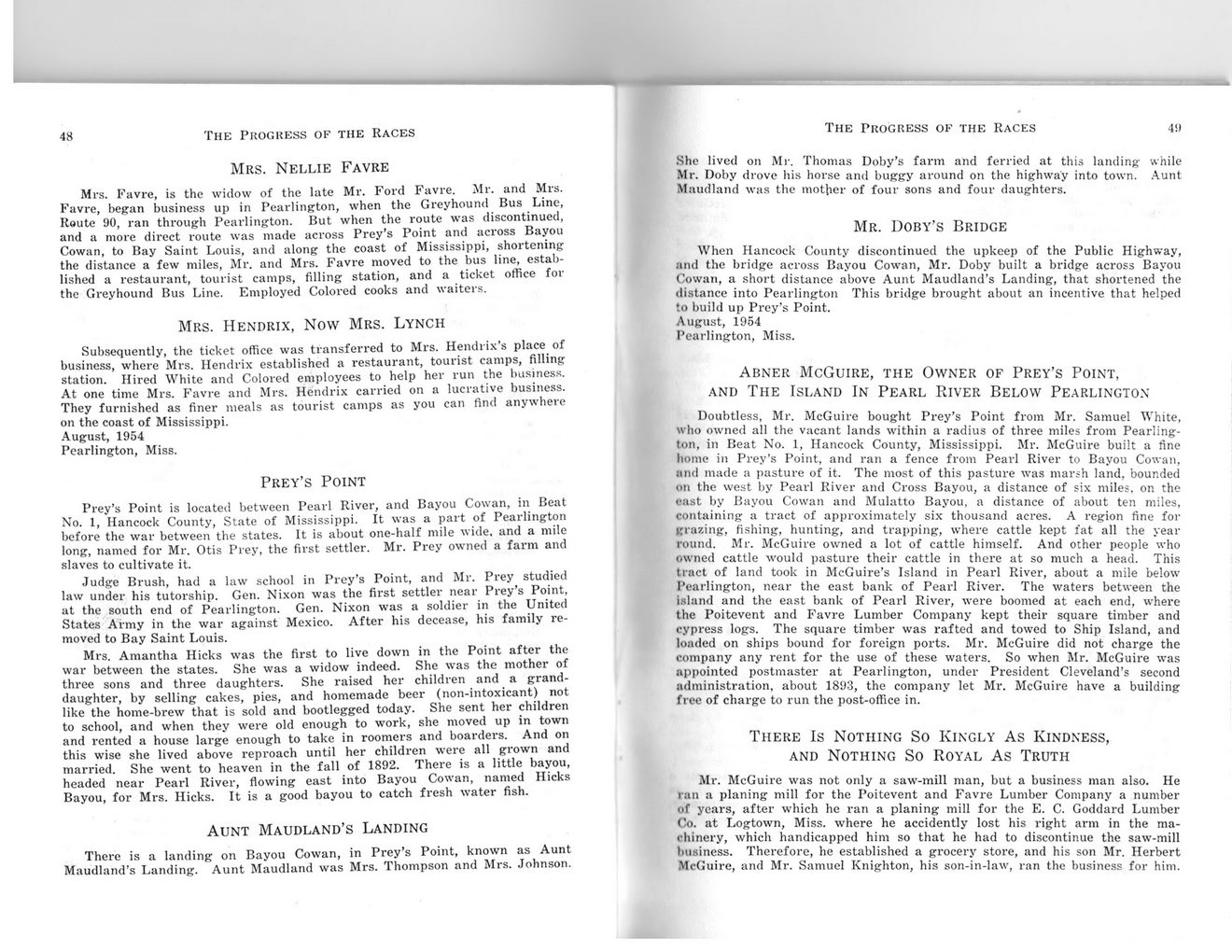This text was obtained via automated optical character recognition.
It has not been edited and may therefore contain several errors.
48 The Progress of the Races Mrs. Nellie Favre Mrs. Favre, is the widow of the late Mr. Ford Favre. Mr. and Mrs. Favre, began business up in Pearlington, when the Greyhound Bus Line, Route 90, ran through Pearlington. But when the route was discontinued, and a more direct route was made across Prey’s Point and across Bayou Cowan, to Bay Saint Louis, and along the coast of Mississippi, shortening the distance a few miles, Mr. and Mrs. Favre moved to the bus line, established a restaurant, tourist camps, filling station, and a ticket office for the Greyhound Bus Line. Employed Colored cooks and waiters. Mrs. Hendrix, Now Mrs. Lynch Subsequently, the ticket office was transferred to Mrs. Hendrix’s place of business, where Mrs. Hendrix established a restaurant, tourist camps, filling station. Hired White and Colored employees to help her run the business. At one time Mrs. Favre and Mrs. Hendrix carried on a lucrative business. They furnished as finer meals as tourist camps as you can find anywhere on the coast of Mississippi. August, 1954 Pearlington, Miss. Prey’s Point Prey’s Point is located between Pearl River, and Bayou Cowan, in Beat No. 1, Hancock County, State of Mississippi. It was a part of Pearlington before the war between the states. It is about one-half mile wide, and a mile long, named for Mr. Otis Prey, the first settler. Mr. Prey owned a farm and slaves to cultivate it. Judge Brush, had a law school in Prey’s Point, and Mr. Prey studied law under his tutorship. Gen. Nixon was the first settler near Prey’s Point, at the south end of Pearlington. Gen. Nixon was a soldier in the United States Army in the war against Mexico. After his decease, his family removed to Bay Saint Louis. Mrs. Amantha Hicks was the first to live down in the Point after the war between the states. She was a widow indeed. She was the mother of three sons and three daughters. She raised her children and a granddaughter, by selling cakes, pies, and homemade beer (non-intoxicant) not like the home-brew that is sold and bootlegged today. She sent her children to school, and when they were old enough to work, she moved up in town and rented a house large enough to take in roomers and boarders. And on this wise she lived above reproach until her children were all grown and married. She went to heaven in the fall of 1892. There is a little bayou, headed near Pearl River, flowing east into Bayou Cowan, named Hicks Bayou, for Mrs. Hicks. It is a good bayou to catch fresh water fish. Aunt Maudland’s Landing There is a landing on Bayou Cowan, in Prey’s Point, known as Aunt Maudland’s Landing. Aunt Maudland was Mrs. Thompson and Mrs. Johnson. The Progress of the Races 49 She lived on Mr. Thomas Doby’s farm and ferried at this landing while Mr. Doby drove his horse and buggy around on the highway into town. Aunt Maudland was the mother of four sons and four daughters. Mr. Doby’s Bridge When Hancock County discontinued the upkeep of the Public Highway, and the bridge across Bayou Cowan, Mr. Doby built a bridge across Bayou Cowan, a short distance above Aunt Maudland’s Landing, that shortened the distance into Pearlington This bridge brought about an incentive that helped to build up Prey’s Point. August, 1954 Pearlington, Miss. Abner McGuire, the Owner of Prey’s Point, and The Island In Pearl River Below Pearlington Doubtless, Mr. McGuire bought Prey’s Point from Mr. Samuel White, who owned all the vacant lands within a radius of three miles from Pearlington, in Beat No. 1, Hancock County, Mississippi. Mr. McGuire built a fine home in Prey’s Point, and ran a fence from Pearl River to Bayou Cowan, and made a pasture of it. The most of this pasture was marsh land, bounded on the west by Pearl River and Cross Bayou, a distance of six miles, on the east by Bayou Cowan and Mulatto Bayou, a distance of about ten miles, containing a tract of approximately six thousand acres. A region fine for grazing, fishing, hunting, and trapping, where cattle kept fat all the year round. Mr. McGuire owned a lot of cattle himself. And other people who owned cattle would pasture their cattle in there at so much a head. This tract of land took in McGuire’s Island in Pearl River, about a mile below Pearlington, near the east bank of Pearl River. The waters between the island and the east bank of Pearl River, were boomed at each end, where the Poitevent and Favre Lumber Company kept their square timber and cypress logs. The square timber was rafted and towed to Ship Island, and loaded on ships bound for foreign ports. Mr. McGuire did not charge the company any rent for the use of these waters. So when Mr. McGuire was nppointed postmaster at Pearlington, under President Cleveland’s second administration, about 1893, the company let Mr. McGuire have a building free of charge to run the post-office in. There Is Nothing So Kingly As Kindness, and Nothing So Royal As Truth Mr. McGuire was not only a saw-mill man, but a business man also. He ran a planing mill for the Poitevent and Favre Lumber Company a number of years, after which he ran a planing mill for the E. C. Goddard Lumber Co. at Logtown, Miss, where he accidently lost his right arm in the machinery, which handicapped him so that he had to discontinue the saw-mill business. Therefore, he established a grocery store, and his son Mr. Herbert McGuire, and Mr. Samuel Knighton, his son-in-law, ran the business for him.

Progress of the Races The Progress Of The Races - By Etienne William Maxson 1930 (27)